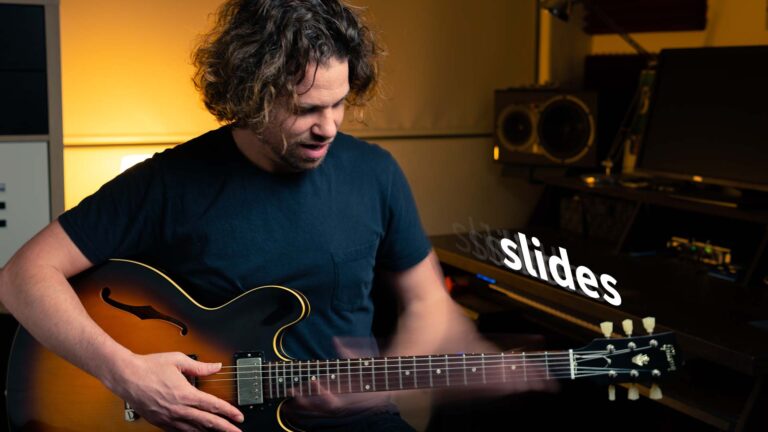The 5 Classic Pentatonic Scale Positions (pt. 4/6)
So far in this pentatonic series, we’ve been developing a horizontal approach to learning the pentatonic scale. You’ve practised the scale on single strings, string pairs and connecting pairs with slides. Now it’s time to get vertical and take a walk on the road most travelled.
The 5 pentatonic positions simplify the fretboard into shapes that are easy to identify and navigate. Learning them will serve you very well. However, these pentatonic ‘boxes’ can become like prisons which some poor souls never escape.
Since you’ve already developed some tools (in lessons 1,2 & 3) to break out of these prisons, you will never have to worry about this problem…..if you’ve been doing your homework so far. Have you?
Don’t underestimate the value in learning these positions. They are integral to developing a horizontal approach across the whole fretboard. With that said, here we go:
The Positions
My advice is to use the provided tabs, but try to get off the page as quickly as possible. Think of it like you’re about to have an exam and you can’t take a ‘cheat sheet’ in with you. How do you do that?
You look for patterns – things that are the same, things that are different – spend some time looking closely at what you’re about to play. Do this and you’ll save a ton of time.
The Classic 5th fret position
For example, in the 5th fret position (Fig.1a), the first note on every string is on the 5th fret. Use your 1st finger for that note on every string. Now you know 50% of the notes in that position! Play them all….now! Next, try to notice something about the other 50%.
You can see that some notes are on the 8th fret and some are on the 7th fret. For the 8th fret ones, use your 4th finger. Let’s play just those strings now (strings 1,2 and 6), and then play both the 5th fret notes and the 8th fret notes on those 3 strings only.
Next, you can see the remaining strings (strings 3,4 and 5) are all adjacent to each other and they use the 7th fret. Play them now using the 3rd finger. Then play both the 5th fret notes and the 7th fret notes on those 3 strings only.
Now you’re ready to play the whole position and you’re likely to get it correct. Most people don’t use this method. They just read through it, make mistakes, they learn these mistakes and then take ages to finally learn it correctly. It takes patience to take a few more moments to look at what you’re doing before you play, but it is worth it and will pay off in spades.

The 12th fret position
Another thing that can really help you memorise the positions is the order you choose to learn them in. The 12th fret position is almost exactly like the 5th fret position. Start by shifting the entire 5th fret position to the 12th fret. So now instead of the first finger playing the 5th fret, it should be playing the 12th on each string and every note that was on the 8th fret is now on the 15th (ie. 12 frets higher), and every 7th fret is now on the 14th. Got that? Ok, good.
So what you just played now is called the E minor pentatonic scale. Here’s the thing: Em pentatonic is exactly the same as Am pentatonic except that the Em pentatonic has a B in it instead of a C. (Don’t worry about the theory behind this, we’ll get to that later!)
So now you just take your Em pentatonic, move all the B’s up to C’s and you have Am pentatonic in the 12th fret position. Before you play it, just have a look at Fig.1b and notice that the first note on the 2nd string is on the 13th fret. Also the 2nd note on the 5th string is on the 15th fret. Those are the C’s. That’s it, now play it.
It doesn’t quite feel as comfortable as the 5th fret position, does it? That’s why the 5th fret position is so popular. It’s that 13th fret that makes it less friendly under the fingers.

The 3rd fret position
Next easiest (in my opinion), is the 3rd fret position (Fig.1c). We’ve already learned all the 5th fret notes when we learned the classic position, so we’ve got 50% of them down already. This time though, use your 4th finger on the 5th fret of each string instead of the first. There are other fingerings I want to talk about another time, but use the 4th finger for now.
The other notes are either on the 2nd fret, or the 3rd fret. If it’s on the 2nd fret, use your first finger. If it’s on the 3rd, use your 2nd finger. This fingering is great for learning it and committing it to memory. It’s also great to practise your weakest finger (the 4th). Notice the first note on every string goes like this: 3 3 2 2 3 3. Easy to remember, innit!

The open position
The open position is just the 12th fret position down the octave. So all of the 12th fret notes are now open strings. That annoying C note on the 13th fret of the 2nd string moves to the 1st fret. Again, look at Fig.1d carefully first before playing it and then try to play the whole thing correctly first go.

The 10th fret position
The 10th fret position forces your left hand to shift out of position a little bit. You’ll notice if you look at Fig.1e, that the 6th, 5th, 4th and 1st strings are all the same – 10th fret and 12th fret. That’s easy to remember so focus more on the other 2. It’s a good idea to work on the challenging things more than the easier things. So spend more some time memorising the 2nd and 3rd strings. You don’t always have to practise the whole position the whole time.

The 8th fret position
The final position is the one next to the classic 5th fret position. We’ve already played all of these notes as part of other positions. The notes on the 7th and 8th frets are from the classic 5th fret position, and the notes on the 9th and 10th are from the 10th fret position we just learnt.
Play the first note on the 8th fret of the 6th string with the 2nd finger. This will set you up to play all the notes in the position without having to shift. There are other fingerings that work well, but use this one while you’re learning it and we’ll explore some other fingerings in future lessons.

The Patterns
Now that you’ve learned all the positions, you need to get out of just playing the thing up and down in order. Patterns help you to build language with the harmonic material that you learn. We’re not learning these patterns to just spew them out when we play, we’re learning them so we can have flexibility all over the guitar.
The 3 consecutive note pattern
The 3 consecutive note pattern is exactly what it sounds like. You play 3 consecutive notes starting from the first note. Then you play 3 consecutive notes starting from the 2nd note, then 3 consecutive notes starting from the 3rd note, and so on. In Fig.2a and Fig.2b, we take this pattern through the whole 5th fret position both forwards and backwards.
Once you have played it through a few times correctly, try doing it from memory.


Now let’s move the same pattern to the 3rd fret:


For these next examples. I’ll just give you the ascending pattern, you can work out the descending pattern. Here’s the ascending open position:

Next, move it to the 8th fret position:

Now move it to the 10th fret position:

Next, move it to the 12th fret position:

I think that the pattern is pretty clear now. If you want to continue to the end up the fretboard, just shift any of the exercises up by 12th frets. For example, Fig.2c starts on the 3rd fret. Move that note up by 12 frets (15th fret) and do the same for every other note in the exercise.
The 4 consecutive note pattern
The 4 consecutive pattern is the same as the 3 consecutive note pattern except you play the first 4 notes of the scale instead of just the first 3.

Now I’m going to leave it up to you to work out how to play this pattern in every position on the guitar like you did with the 3 consecutive note pattern. You know the process now, so you can take any pattern in A minor pentatonic and apply this approach.
Final Thoughts
If you wanted, you could now go nuts with learning as many patterns as possible. But I would settle down and concentrate on really knowing these positions so you can’t get them wrong, and then nail these patterns. Once you feel comfortable with this, move on to the next lesson in this series. Good luck and have fun!





